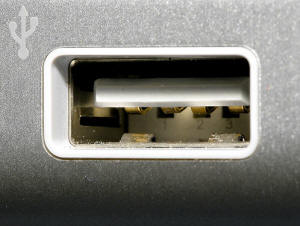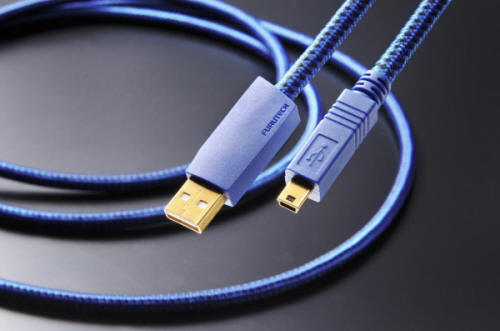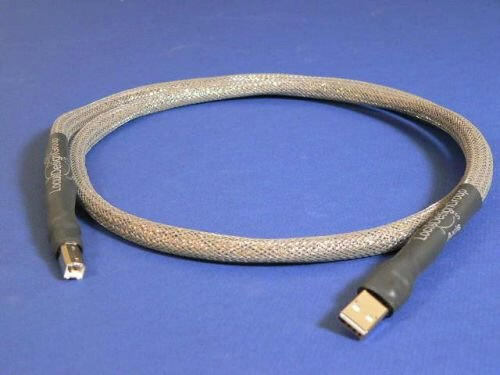|
You are reading the older HTML site Positive Feedback ISSUE 49may/june 2010
USB Mini Survey
The following mini-survey is part of an ongoing series of articles documenting my transition from a CD and LP based listener to computer based listener. Computer based audio has been a part of my listening experience for years but mostly as casual background music. Within the past eighteen months however, my appreciation for computer based audio has increased greatly due to recent experiences with outboard digital to analog converters. In the ensuing months I reviewed a variety of USB DAC devices. As a result, I sold my eight year old Magnum Dynalab 208 Discrete Receiver and upgraded to Magnum's new MD 209 with integrated USB DAC. The focus of this article is USB cables. I do not claim to possess intimate knowledge of the scientific laws or data to support my observations; however I can relay my observations on the effects of three different USB cables in my system. Hopefully, some of you with similar situations may find my results interesting. My method for evaluating the cables was uncomplicated. Over the span of several quiet mornings with no one in the house but me, I listened to an iTunes playlist of music that I felt might reveal differences in sound among the three cables. Then I crawled around on the carpet to reach behind the Mac Mini and Magnum to disconnect or insert cables and quickly return to the listening chair to repeat the playlist. On many an occasion, by lunch time my knees were chaffed, but I had a solid impressions of the sounds of the cables. In general, the most significant difference among the three cables was their ability to convey depth of perception. Not surprisingly, this ability, and thus musical realism, was directly related to their cost. The first cable I listened to was a generic beige colored USB printer cable. "Enterprising Young Men" from the 2009 Star Trek movie is dramatic piece of orchestral music with dynamic percussive elements and blaring brass. The generic cable sounded acceptable but lacked specific details about the size and shape of the orchestra. The overall perspective was "back of hall" where sounds tend to blend into an amorphous whole. The leading and trailing edges of sounds were also somewhat muted. To put it briefly, listening to music with the generic USB cable was like listening to an average CD player that sounded satisfying, though ultimately uninvolving. Next I replaced the generic cable with Furutech's GT2 USB cable which is manufactured with higher grade materials and shielding. The change resulted in a more refined musical perspective. The orchestra could now be distinguished by its different sections with significantly more clarity and focus. The vast dimensions of the recording hall also began to emerge. The perception of depth and layering of instruments from front to back was also greatly enhanced in comparison to the generic printer cable. On this basis alone, Furutech's GT2 USB cable garners a high recommendation for its value and performance.
Then I switched to the Locus Design's Axis cable. This cable is virtually handmade with select materials and individually shielded strands. The Axis opened up spaces within the recording even more. The lifelike orchestral image and depth of perception produced by the Axis was quite very impressive. I could perceive sound reverberating into the far corners of the hall. Musical details were now laid out in clear daylight. French horns were now unquestionably muted. The complimentary musical lines played by violins and violas were precisely rendered and engaging. An assortment of rattles and shakers are used to great effect to drive the rhythm along and swell to a dramatic peak punctuated by sharply struck tympani drums.
Next, I played to a favorite vocal selection to listen for any tonal anomalies or color shifts. "Love and Happiness" by Emmylou Harris and Mark Knopfler from their CD All the Road Running is a very beautiful song. I often return to this track because it combines the unembellished elements of Emmylou's plaintive voice and strummed acoustic guitar to great emotional effect. The generic printer cable made tonal colors sound slightly faded and imprecise like a massed produced poster of fine art. The Furutec cable afforded me higher contrasts and sharper images of the performer's voices and instruments. The dimensions of the recording space were much better defined. The Axis, however, rendered musical details and the illusion of space with absolute clarity. The song begins with gently strummed acoustic guitars, one with capo around the middle of the neck. Then Emmylou sings a verse followed by Mark's distinctive basso speak-sing style. The drummer keeps time on a wooden block for a few measures like the tick-tock of an old grandfather clock before laying the stick sideways on the snare for a more metallic beat. The Locus Design cable's accurate portrayal of these micro musical events greatly enhanced my appreciation of this and many other recordings. Poncho Sanchez' latest recording is Psychedelic Blues on Concord. I highly recommend downloading the song "Willie Bobo Medley". It's a three part medley of some of Willie's most popular tunes updated with Poncho's band in full funk mode and a tip of the hat to the late Willie Bobo. The recording as played through the generic printer cable was enjoyable but images were flattened and space relations were ill defined. The Furutech cable exposed more musical details and well defined images on a consistent soundstage. The Axis cable dialed in resolution, space, and depth of perception to maximum degree. Conga and cowbell were vividly portrayed with natural timbres and overtones and decays. Trombone, sax, and trumpet retained their unique sonic signatures and location on deep soundstage. Bass rolled along with firm authority. Prior to my exposure to USB cables from Furutech and Locus Design, I was unaware USB could have such a significant impact on the sound of music given that all they do is transfer ones and zeros to the DAC. However, I now realize that selecting a high quality USB cable for digital transfer is just as important as choosing an interconnect for analogue signals. If you are currently using a generic printer cable between your computer and a USB DAC device, I urge you to upgrade to a higher quality cable such as Furutech's excellent GT2. The interval of performance between the generic cable and the GT2 was considerable. Music sounded more alive and open. For listeners seeking the highest degree of performance and the means to acquire it, the Locus Design Axis is highly recommended. On a final note, wireless data transfer may soon make USB cables irrelevant. In the meantime, however, seek out as high quality USB cable as your budget will allow.
GT2
Axis
Furutech
Locus Design
|



